The Sausage Casing Market is estimated to be valued at USD 4.2 billion in 2025 and is projected to reach USD 6.7 billion by 2035, registering a compound annual growth rate (CAGR) of 4.7% over the forecast period.
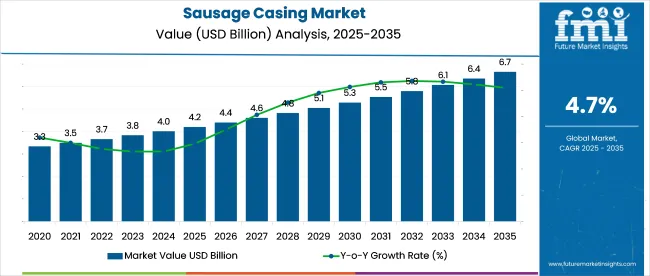
The sausage casing market is witnessing strong demand growth due to increasing consumption of processed meat products and expansion of industrial food manufacturing capabilities across emerging and developed economies. The growing emphasis on standardization, hygiene, and production efficiency has shifted preference toward advanced casing solutions that enable longer shelf stability, consistent product shape, and faster throughput in filling operations.
Innovations in casing materials, along with improvements in automated stuffing and linking equipment, are enabling manufacturers to scale operations while maintaining quality and safety compliance. Moreover, changing dietary habits, urbanization, and the rising demand for ready-to-cook protein-based foods are accelerating market expansion. Manufacturers are responding by offering customizable casing options that meet regulatory standards and cater to various product formats.
With regulatory bodies placing greater emphasis on food traceability and processing transparency, the market is expected to continue its growth trajectory through higher penetration of synthetic and standardized casing solutions.
The market is segmented by Type and Application and region. By Type, the market is divided into Synthetic Casing, Natural Casing, and Alternative Casing. In terms of Application, the market is classified into Industrial and Household.
Regionally, the market is classified into North America, Latin America, Western Europe, Eastern Europe, Balkan & Baltic Countries, Russia & Belarus, Central Asia, East Asia, South Asia & Pacific, and the Middle East & Africa.
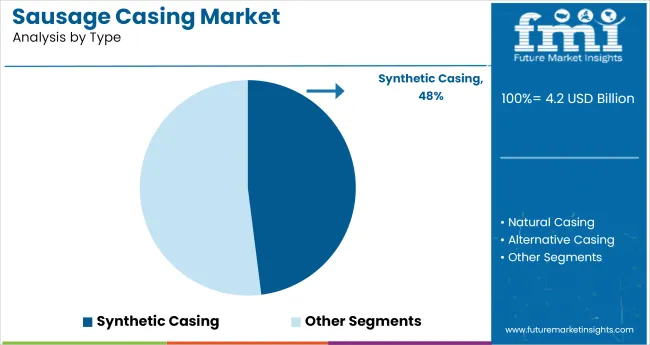
Synthetic casings are projected to hold a 48.0% revenue share in the sausage casing market by 2025, making them the leading product type. This dominance is being driven by their consistency in shape, improved mechanical strength, and higher suitability for industrial-scale sausage production. Unlike natural casings, synthetic variants allow for better uniformity in size and are easier to handle in automated machinery, enabling faster and cleaner filling processes.
Their ability to withstand high temperatures and mechanical stress without breakage makes them ideal for smoked, cooked, or dry sausage products. Furthermore, synthetic casings offer longer shelf life and lower microbial risk, addressing critical food safety concerns in mass production environments.
Compatibility with various formulations, including plant-based alternatives, and regulatory acceptance for food-grade polymer use have also contributed to their rising adoption. As meat processors scale operations and aim for greater efficiency, synthetic casings are expected to maintain a strong foothold in both developed and emerging markets.
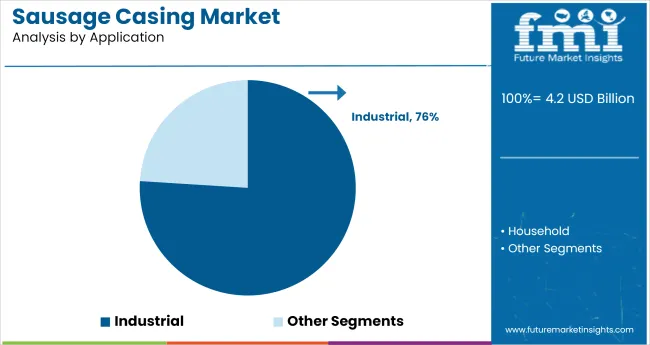
The industrial segment is expected to dominate the sausage casing market with a 76.0% revenue share in 2025. This leading position is attributed to large-scale production requirements in commercial meat processing facilities, which rely heavily on standardized casing solutions to maintain output consistency and minimize operational downtime.
Industrial processors prioritize casings that can accommodate automated filling and clipping equipment, ensuring high throughput with minimal waste.
Additionally, stringent quality control and food safety regulations in the industrial meat supply chain have accelerated the shift toward synthetic and collagen-based casings, which offer traceability and hygiene assurance.
The demand for value-added processed meat products such as cooked sausages, hot dogs, and specialty blends has also reinforced the segment’s dominance. As global protein consumption continues to rise and industrial food processing infrastructure expands, the need for high-performance, scalable casing solutions will remain a critical driver of market growth.
This market is rising in demand owing to rapidly increasing meat consumption, population growth and urbanization. Also, the rising consumer preference to natural casings over artificial casings is also highly impacting the growth of the sausage casings market share in the forecast period of 2025 to 2035.
The rising urbanization, increase in disposable income, along with the increasing number of fast-food restaurant chains are anticipated to flourish the growth of the market owing to the above-mentioned reasons and is also is projected to grow substantially during the forecast period.
Furthermore, the increasing preference for convenience food products, including in the emerging countries along with the developed regions, is also expected to push the growth of this market during the above-mentioned forecast period.
The major factor which actively drives the demand of sausage casings market is the increasing demand from commercial food restaurants. Likewise, the increasing meat processing industry in emerging markets will further offer various growth opportunities for the growth of this market over the forecast period of 2025 to 2035.
Rising number of fast-food chains that sell meat products, busy lifestyles of the people and growing demand for meat products in the street food sector is likely to drive the demand for casings in the global market.
There has been an increase in the consumption of processed meat in household preparations as well. The time available for cooking has reduced because of the increased urban population and hectic work life.
The processed food industry offers minced meat in the form of sausages that is easy to cook at a minimal time. This has led to increased demand for sausage casings over the last decade and is expected to continue during the forecast period.
Asia-Pacific is expected to expand at a significant growth rate over the forecast period of 2025 to 2035 owing to the increasing meat production and consumption, rising westernization along with the growing population and urbanization within this region.
Asia-Pacific possesses lucrative growth potential for this market during the forecast period. This is mainly attributed to the rising number of fast-food restaurant chains, rising expenditure on sausage casings, growing westernization, growing population & urbanization.
Most of the demand for casings in this region will be driven by developing countries, including Indonesia, Thailand, and India, due to the increasing livestock production and processing and growing focus on processed meat products.
The need for convenience is the major driver behind this region’s growing processed meat markets. A majority of the market demand in the Asia Pacific market is still mostly projected to come from China.
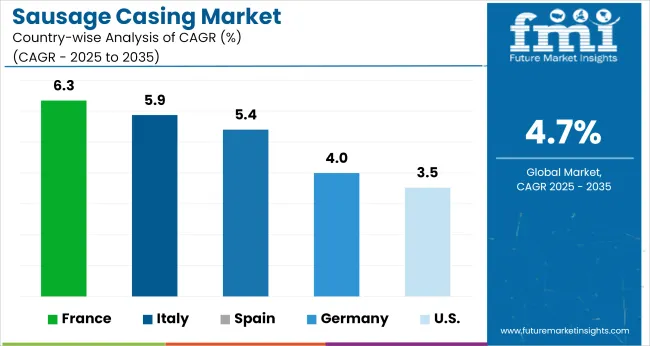
Europe leads the sausage casings market because of the rapidly rising preference to the convenience products in this particular region.
The prominent position of Europe in this market is primarily attributed to the presence of a large number of sausage manufacturers, changing food consumption patterns in favor of convenience food, and a surge in meat and sausage consumption.
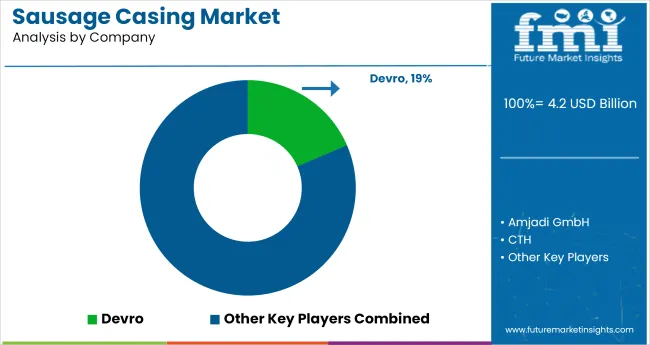
The major players covered in the casing market report are
The report is a compilation of first-hand information, qualitative and quantitative assessment by industry analysts, inputs from industry experts and industry participants across the value chain.
The report provides in-depth analysis of parent market trends, macro-economic indicators and governing factors along with market attractiveness as per segments. The report also maps the qualitative impact of various market factors on market segments and geographies.
The global sausage casing market is estimated to be valued at USD 4.2 billion in 2025.
The market size for the sausage casing market is projected to reach USD 6.7 billion by 2035.
The sausage casing market is expected to grow at a 4.7% CAGR between 2025 and 2035.
The key product types in sausage casing market are synthetic casing, natural casing and alternative casing.
In terms of application, industrial segment to command 76.0% share in the sausage casing market in 2025.






Our Research Products

The "Full Research Suite" delivers actionable market intel, deep dives on markets or technologies, so clients act faster, cut risk, and unlock growth.

The Leaderboard benchmarks and ranks top vendors, classifying them as Established Leaders, Leading Challengers, or Disruptors & Challengers.

Locates where complements amplify value and substitutes erode it, forecasting net impact by horizon

We deliver granular, decision-grade intel: market sizing, 5-year forecasts, pricing, adoption, usage, revenue, and operational KPIs—plus competitor tracking, regulation, and value chains—across 60 countries broadly.

Spot the shifts before they hit your P&L. We track inflection points, adoption curves, pricing moves, and ecosystem plays to show where demand is heading, why it is changing, and what to do next across high-growth markets and disruptive tech

Real-time reads of user behavior. We track shifting priorities, perceptions of today’s and next-gen services, and provider experience, then pace how fast tech moves from trial to adoption, blending buyer, consumer, and channel inputs with social signals (#WhySwitch, #UX).

Partner with our analyst team to build a custom report designed around your business priorities. From analysing market trends to assessing competitors or crafting bespoke datasets, we tailor insights to your needs.
Supplier Intelligence
Discovery & Profiling
Capacity & Footprint
Performance & Risk
Compliance & Governance
Commercial Readiness
Who Supplies Whom
Scorecards & Shortlists
Playbooks & Docs
Category Intelligence
Definition & Scope
Demand & Use Cases
Cost Drivers
Market Structure
Supply Chain Map
Trade & Policy
Operating Norms
Deliverables
Buyer Intelligence
Account Basics
Spend & Scope
Procurement Model
Vendor Requirements
Terms & Policies
Entry Strategy
Pain Points & Triggers
Outputs
Pricing Analysis
Benchmarks
Trends
Should-Cost
Indexation
Landed Cost
Commercial Terms
Deliverables
Brand Analysis
Positioning & Value Prop
Share & Presence
Customer Evidence
Go-to-Market
Digital & Reputation
Compliance & Trust
KPIs & Gaps
Outputs
Full Research Suite comprises of:
Market outlook & trends analysis
Interviews & case studies
Strategic recommendations
Vendor profiles & capabilities analysis
5-year forecasts
8 regions and 60+ country-level data splits
Market segment data splits
12 months of continuous data updates
DELIVERED AS:
PDF EXCEL ONLINE
Market Share Insights of Leading Sausage Casing Providers
Casing Pipe Market Analysis Size and Share Forecast Outlook 2025 to 2035
Well Casing Market Size and Share Forecast Outlook 2025 to 2035
Vegan Casing Market Size and Share Forecast Outlook 2025 to 2035
Split Casing Pumps Market
Coated Casing Market Size and Share Forecast Outlook 2025 to 2035
Aluminum Casing of the Blade Battery Market Size and Share Forecast Outlook 2025 to 2035
Examining Market Share Trends in the Collagen Casings Industry
Collagen Casings Market Analysis - Product Type & End Use Trends
UK Collagen Casings Market Insights – Demand, Size & Industry Trends 2025–2035
Plant-Based Sausages Market Insights - Consumer Trends 2025 to 2035
Spice Coated Casing Market Analysis - Size, Share & Forecast 2025 to 2035
USA Collagen Casings Market Analysis – Size, Share & Forecast 2025–2035
ASEAN Collagen Casings Market Report – Trends, Demand & Outlook 2025–2035
Edible Collagen Casing Market Size and Share Forecast Outlook 2025 to 2035
Europe Collagen Casings Market Report – Demand, Growth & Industry Forecast 2025–2035
Competitive Overview of Edible Collagen Casing Market Share
Australia Collagen Casings Market Outlook – Share, Growth & Forecast 2025–2035
Latin America Collagen Casings Market Trends – Size, Demand & Forecast 2025–2035
Demand for Spice Coated Casing in EU Size and Share Forecast Outlook 2025 to 2035

Thank you!
You will receive an email from our Business Development Manager. Please be sure to check your SPAM/JUNK folder too.
Chat With
MaRIA